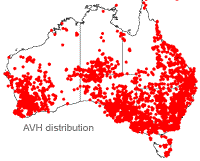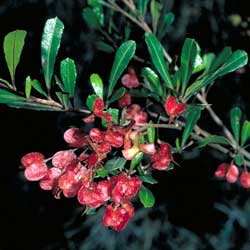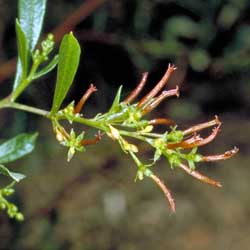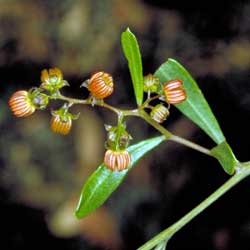Dodonaea viscosa
Sticky Hop Bush
Dodonaea viscosa, commonly called ‘sticky hop bush’, is a member of the Sapindaceae family. Dodonaeas are known as hop bush as they were used to make beer by early European Australians. Dodonaea viscosa has also been traditionally used by Aboriginal Australians to treat toothache, cuts and stingray stings.
 Dodonaea viscosa can be found in every state and territory of Australia. However it is highly variable and consequently has seven sub-species recognised. The seven sub-species of Dodonaea viscosa are D.viscosa subsp. angustifolia, D.viscosa subsp. angustissima, D.viscosa subsp. burmanniana, D.viscosa subsp. cuneata, D.viscosa subsp. mucronata, D.viscosa subsp. spatulata and D.viscosa subsp. viscosa. These sub-species each have a distinct habitat and can handle varying degrees of drought. The major differences of the sub-species are in distribution, form and leaf characteristics. It is best to plant the sub-species found in the local area; this species will have adapted to these particular environmental conditions.
Dodonaea viscosa can be found in every state and territory of Australia. However it is highly variable and consequently has seven sub-species recognised. The seven sub-species of Dodonaea viscosa are D.viscosa subsp. angustifolia, D.viscosa subsp. angustissima, D.viscosa subsp. burmanniana, D.viscosa subsp. cuneata, D.viscosa subsp. mucronata, D.viscosa subsp. spatulata and D.viscosa subsp. viscosa. These sub-species each have a distinct habitat and can handle varying degrees of drought. The major differences of the sub-species are in distribution, form and leaf characteristics. It is best to plant the sub-species found in the local area; this species will have adapted to these particular environmental conditions.
As an example, Dodonaea viscosa subsp. mucronata is mainly found in central Australia but also has populations in Western Australia, Queensland and New South Wales. It naturally occurs in arid regions, particularly in rocky areas. Dodonaeaviscosa subsp. mucronata grows well in rocky or sandy soils.
D. viscosa subsp. mucronata is an erect to spreading shrub growing from 1.5 to 4 metres tall. The leaves are sticky leathery. The foliage is evergreen, with the leaf shape usually spatulate (spoon-shaped).
In general, Dodonaea viscosa is an extremely hardy species and is able to resprout from the base. The stand-out horticultural feature of this species is the brilliant colour of the capsules. Other desirable features include its successful use as a hedge due to the dense habit. There is also a popular non-native form with purple foliage, referred to as Dodonaea ‘Purpurea’.
Dodonaea viscosa flowers are inconspicuous, with no petals. These flowers occur during spring and summer and are less than a centimetre in size. The plants are dioecious; i.e. the flowers are male or female and usually occur on separate plants.
The pollen is wind dispersed. However, fertilisation does not need to occur for the capsules to develop. Fertilised capsules can take up to 11 months to mature with unfertilised capsules maturing faster. Over this time the capsules will change colour from a green or cream colour through to a brilliant red. These winged capsules are only produced on female or bisexual flowers and are approximately 2 cm 2 in size.
Dodonaea viscosa can be easily propagated from both cuttings and seeds. Cuttings are often preferred to guarantee a female plant with the colourful capsules. The optimum cutting material is young growth that has just firmed. It is best to then use a rooting hormone. Straight perlite may be used as the medium or as a mixture with peat or coconut fibre. If seeds are used for propagation a treatment of soaking in very hot water prior to sowing will assist germination.
This species prefers well-drained soils and requires a well-lit area. It can tolerate part shade but the capsules will not be as spectacular in colour if shaded. This species can tolerate dry conditions and can also handle some frosts. Little maintenance is necessary. However, regular tip pruning will promote growth and branching. Scale may be an issue due to the viscous leaves. If this is the case, an application of white oil is an effective remedy.
Text by Melina McDowell (2007 Botanical Intern)
Name Meaning: Dodonaea viscosaDodonaea - named after a Flemish botanist of the 16 th century; Rembert Dodoens viscosa - from the Latin term viscosus meaning sticky |
References
Association of Societies for Growing Australian Plants (ASGAP). (2006) Dodonaea viscosa. ASGAP. http://asgap.org.au/d-vis.html [Accessed January 29 2007].
Australian National Botanical Gardens (ANBG). (2006) Aboriginal Trail. ANBG. http://www.anbg.gov.au/anbg/aboriginal-trail.html [Accessed February 3 2007].
Closs, J. (2002) Dodonaea - The Hop Bush. Australian Plants Online. http://asgap.org.au/APOL27/sep02-1.html [Accessed January 29 2007].
Corangamite Catchment Management Authority (CCMA). (2006) Dodonaea viscosa; Sticky Hop-bush. CCMA. http://www.ccma.vic.gov.au/GLOBAL/uploaded/Speciesnotes-Dodonaeaviscosa.pdf [Accessed January 29 2007].
Elliot, W. Roger and Jones, David L. (1984) Encyclopaedia of Australian Plants Suitable for Plant Cultivation. Lothian Publishing Company Pty Ltd, Melbourne, Australia.
University of Hawaii. (unkn.) Dodonaea viscosa. Hawaiian Native Plant Propagation Database. http://www2.hawaii.edu/~eherring/hawnprop/dod-visc.htm [Accessed January 29 2007].
West, J.G. (1984) A taxonomic revision of Dodonaea (Sapindaceae) in Australia, Brunonia 7: 1-194.
![An Australian Government Initiative [logo]](/images/austgovt_brown_90px.gif)




